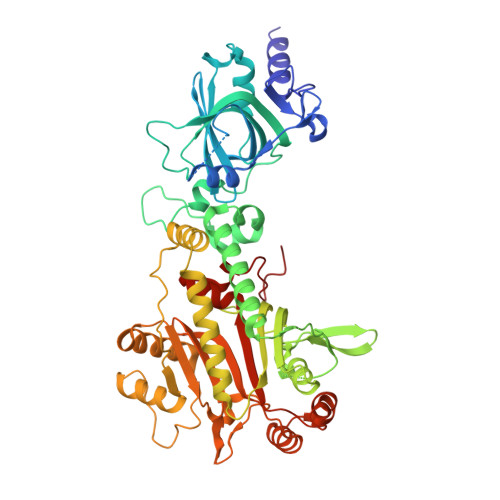Natural product-mediated reaction hijacking mechanism validates Plasmodium aspartyl-tRNA synthetase as an antimalarial drug target.
Ketprasit, N., Tai, C.W., Sharma, V.K., Manickam, Y., Khandokar, Y., Ye, X., Dogovski, C., Hilko, D.H., Morton, C.J., Braun, A.C., Leeming, M.G., Siddharam, B., Shami, G.J., Pradeepkumar, P.I., Panjikar, S., Poulsen, S.A., Griffin, M.D.W., Sharma, A., Tilley, L., Xie, S.C.(2025) PLoS Pathog 21: e1013057-e1013057
- PubMed: 40627786
- DOI: https://doi.org/10.1371/journal.ppat.1013057
- Primary Citation of Related Structures:
9M5M, 9M5N, 9M5O, 9NPJ - PubMed Abstract:
Malaria poses an enormous threat to human health. With ever-increasing resistance to currently deployed antimalarials, new targets and starting point compounds with novel mechanisms of action need to be identified. Here, we explore the antimalarial activity of the Streptomyces sp natural product, 5'-O-sulfamoyl-2-chloroadenosine (dealanylascamycin, DACM) and compare it with the synthetic adenosine monophosphate (AMP) mimic, 5-O-sulfamoyladenosine (AMS). These nucleoside sulfamates exhibit potent inhibition of P. falciparum growth with an efficacy comparable to that of the current front-line antimalarial, dihydroartemisinin. Exposure of P. falciparum to DACM leads to inhibition of protein translation, driven by eIF2α phosphorylation. We show that DACM targets multiple aminoacyl-tRNA synthetases (aaRSs), including the cytoplasmic aspartyl tRNA synthetase (AspRS). The mechanism involves hijacking of the reaction product, leading to the formation of a tightly bound inhibitory amino acid-sulfamate conjugate. We show that recombinant P. falciparum and P. vivax AspRS are susceptible to hijacking by DACM and AMS, generating Asp-DACM and Asp-AMS adducts that stabilize these proteins. By contrast, human AspRS appears less susceptible to hijacking. X-ray crystallography reveals that apo P. vivax AspRS exhibits a stabilized flipping loop over the active site that is poised to bind substrates. By contrast, human AspRS exhibits disorder in an extended region around the flexible flipping loop as well as in a loop in motif II. These structural differences may underpin the decreased susceptibility of human AspRS to reaction-hijacking by DACM and AMS. Our work reveals Plasmodium AspRS as a promising antimalarial target and highlights structural features that underpin differences in the susceptibility of aaRSs to reaction hijacking inhibition.
Organizational Affiliation:
Department of Biochemistry and Pharmacology, Bio21 Molecular Science and Biotechnology Institute, The University of Melbourne, Melbourne, Australia.


















